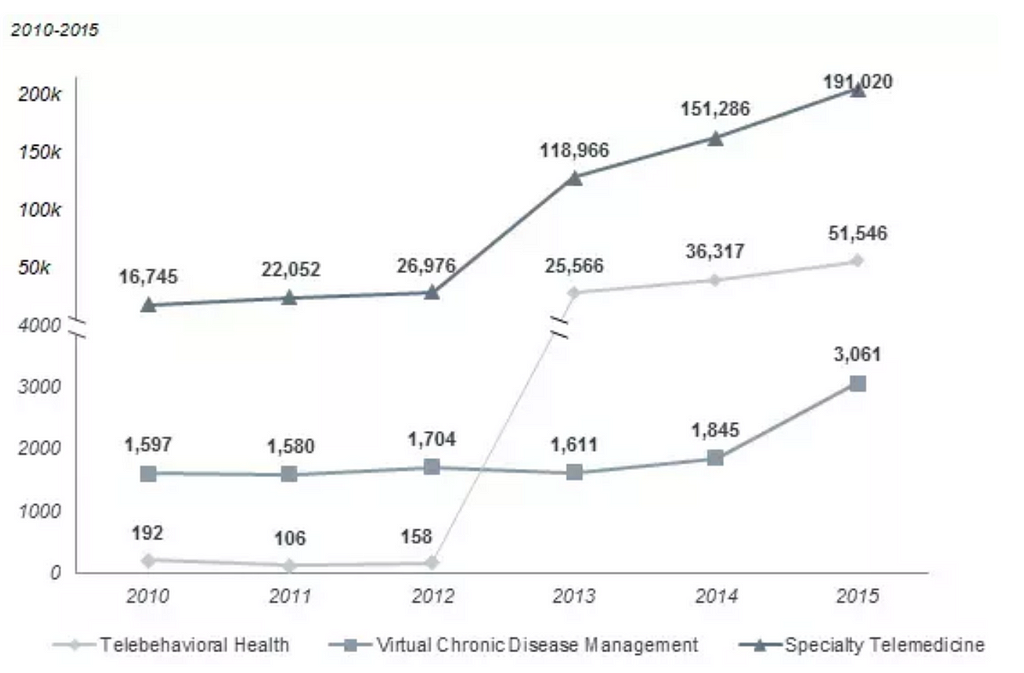Latest news about Bitcoin and all cryptocurrencies. Your daily crypto news habit.
 By Nitin Goyal, MD, Orthopaedic Surgeon, Founder & CEO at Pulse Platform. Originally published on Quora.
By Nitin Goyal, MD, Orthopaedic Surgeon, Founder & CEO at Pulse Platform. Originally published on Quora.
The delivery of remote healthcare services using technology is the simplest way to define telemedicine.
When you think about it, this shift to remote (or on-demand) service has already happened in most industries. Take banking, for example. The concept of walking down the street to a branch just to deposit a check at a brick and mortar store feels outdated, cumbersome, and unnecessary.
The same could be said for the notoriously cumbersome experience of waiting in a hospital lounge to see a doctor.
Over the past decade, telehealth advancements have improved tremendously, as has patient adoption. But according to industry data, what’s leading the charge isn’t telemedicine but behavioral health (of which there was a huge leap forward between 2012–2013) and specialty telemedicine services.
An example of this is shown below, displaying three areas of telemedicine experiencing rapid growth.
Medicare Fee-For-Service Trends In Telehealth Volumes
What’s driving telemedicine adoption isn’t necessarily technology but societal behavior and lifestyle habits.
The truth is, the technology for telehealth services has been around for a while now — the telephone. And soon, things like Skype became options for communication. And then FaceTime on your smartphone.
In 2015, American Well did a survey and found 64% of consumers were open to visiting a doctor via video. It also found consumers are most receptive to the idea of telemedicine services when a video component is involved, because it makes them feel more engaged. They believe video will help their doctor make a more accurate diagnosis.
Interestingly enough, 88% said they preferred to choose a doctor based on the experience level listed in their online profile, emphasizing physicians need to be publicly active on the Internet — something I personally invest a significant amount of effort into.
And lastly, the survey cited that consumers see telemedicine as a way to save money. Interestingly, 62% of consumers “thought a video visit should cost less than an in-person visit.” This is an intriguing point, since an hour of a physician’s time is still an hour.
But these insights are only a piece of a much larger picture.
Here’s what effective telemedicine will look like in the next 5, 10, 20 years.
Today’s consumers are more mobile — in every sense of the word. People prefer to text instead of call, because in most cases, calling takes too long.
People like to pick and choose what they want, when they want it. They don’t want to coordinate their schedule around their physician’s schedule. (They expect it to be the other way around).
People prefer transparency over everything and want answers to their questions on demand, because tools like Google have created this habit in every other facet of their lives.
When we think about telemedicine and its use cases, the conversation gets caught up in how to make something flawed work better. Specifically, about how consumers expect a telehealth visit to cost less than an in-person visit. In reality, this doesn’t solve the physician’s challenge of only being available so many hours in a day.
An hour is still an hour.
The future of telemedicine is not just in streamlining those processes but putting processes in place to ensure a patient’s questions are not only answered — they’re also anticipated. That’s the true digital health solution.
Telemedicine is heavily interlinked with the innovation happening in the digital health industry as a whole. And what consumers want, not just in regards to telehealth but all healthcare services, is to feel at ease, educated about their health, and engaged with their physician if and when it’s absolutely necessary.
As a surgeon, there are plenty of times my patients have very simple (but important) questions that could have easily been answered in another way — a way that would have saved them the time of waiting in the lounge.
So, the measures for telemedicine effectiveness will soon be based on how much time it saves a consumer. And not just travel time to a doctor’s office. It will include all of the little questions that pop up along the way and could easily be communicated through an app or a message system, rather than booking a time to talk to a physician directly.
This trend is already happening in other facets of digital health. And it’s only going to continue pushing the boundaries of telemedicine as well.
By Nitin Goyal, MD, Orthopaedic Surgeon, Founder & CEO at Pulse Platform. Originally published on Quora.For more trending tech answers from Quora, visit HackerNoon.com/quora.
The Future of Telemedicine was originally published in Hacker Noon on Medium, where people are continuing the conversation by highlighting and responding to this story.
Disclaimer
The views and opinions expressed in this article are solely those of the authors and do not reflect the views of Bitcoin Insider. Every investment and trading move involves risk - this is especially true for cryptocurrencies given their volatility. We strongly advise our readers to conduct their own research when making a decision.